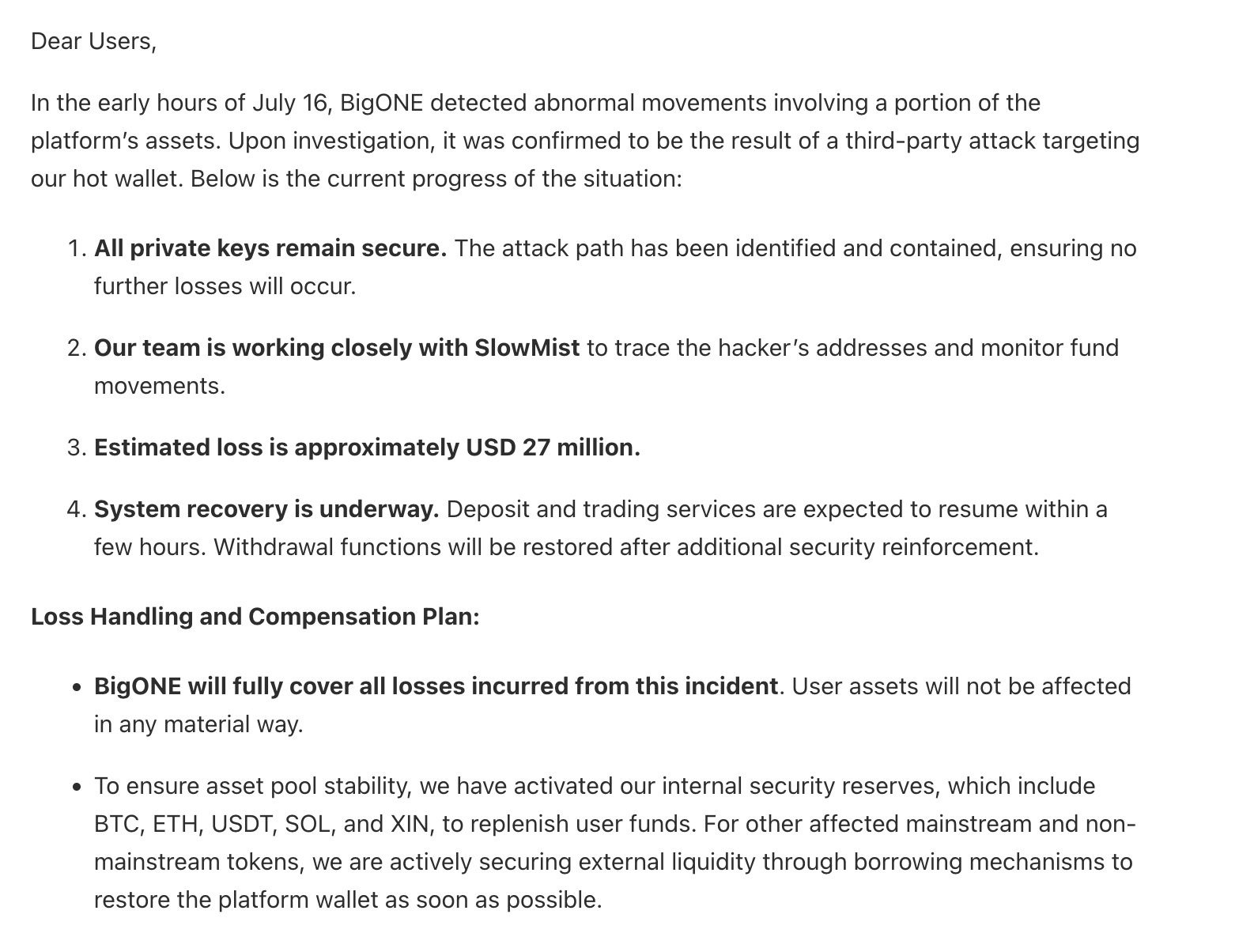Another day, another crypto hack! This time it's BigONE, ironically becoming the "big one" in cybersecurity headlines. Let's dive straight into how this fiasco unfolded, why it matters, and what every crypto exchange must learn to stay ahead of such cyber mayhem.
How the Hack Happened?
On July 16, BigONE's hot wallets coughed up roughly $27 million in a sudden attack, spanning multiple blockchains including Bitcoin, Ethereum, USDT, DOGE, SHIB, SOL, and a handful of others. The culprit wasn't a cracked private key, nor a traditional brute force attack; this time, it was more subtle and insidious: a third-party supply-chain vulnerability.
The attacker cleverly exploited the logic governing BigONE's hot wallet infrastructure. In simpler terms, imagine having a sturdy vault door (your wallet), but the thief cleverly bypasses it by hijacking the company that designed the door mechanism itself. The attacker altered logic within production-level code through compromised third-party software, allowing them to silently funnel funds away without triggering alarms, initially.

BigONE quickly sprang into action, pausing withdrawals, reinforcing security, and enlisting blockchain forensic experts (SlowMist) to track the stolen crypto, now likely being laundered through crypto mixers and decentralized exchanges.
Key Lessons from the BigONE Breach
1. Supply Chain Trust is Dangerous
Your internal security might be airtight, but trusting third-party code blindly is akin to giving strangers the keys to your vault. Regular vetting, audits, and real-time monitoring of third-party components are essential.
2. Hot Wallet ≠ Safe Wallet
Hot wallets offer convenience but come with huge "hot mess" risks. Always maintain minimal balances in hot wallets and maximize your cold storage strategies.
3. Incident Response is Everything
BigONE's swift containment and immediate guarantee of reimbursement kept panic minimal. Proactive responses build trust faster than PR spin ever could.
4. Real-Time Anomaly Detection
The attack wasn't instantaneously detected due to clever exploit logic. Implementing behavioral analysis and anomaly detection would have potentially caught this breach sooner.
How to Stay Secure (For Real)
Here's your "Crypto Security Survival Guide" to avoid becoming the next "BigONE":
Zero Trust Architecture
Assume every system and every partner can (and will eventually) fail or betray you.
Code Integrity Checks
Implement continuous validation and integrity checks across the entire development lifecycle, particularly when third-party integrations are involved.
Diversify Security Layers
Use multi-layered defenses, including anomaly detection, real-time monitoring, and rigorous internal controls.
Rehearse the Worst
Regularly conduct cybersecurity drills simulating insider threats, third-party compromises, and hot wallet exploits.
Wrapping Up the "Big" Lesson
Crypto platforms, exchanges, and wallets are favorite targets because, frankly, that's where the money is! The BigONE breach reminds us that hackers never sleep; they evolve, adapt, and exploit trust at the weakest links. To outpace cybercriminals, we must learn faster, trust less blindly, and respond smarter.
In crypto security, prevention is ideal, detection is essential, but a powerful response is the ultimate currency.
At Resonance Security, we help projects fortify their infrastructure with our suite of offensive simulations, continuous monitoring, and real-time detection tools. If you’re building cross-chain vaults, AMMs, exchanges, lending protocols, or anything else related to crypto & web3, now is the time to take security seriously.
Book a FREE exploration call to discuss further with us how we can help you.
Stay secure, or stay sorry. The choice, crypto friends, is entirely yours.
About the Author
Rhythm Jain is the Marketing Development Manager at Resonance Security, bringing several years of experience in marketing and business development. As a cybersecurity enthusiast turned marketing professional, he specializes in crafting strategies that amplify brand presence and drive user engagement across web2 and web3 ecosystems.
















.png)